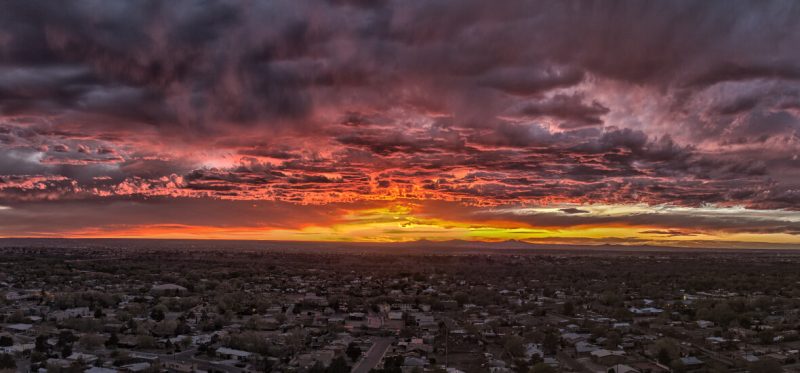Greetings! Sunset and sunrise are my absolute favorite times to fly. Here in Albuquerque sunrise and sunset can transform a fairly boring skyline into something truly amazing! Many photographers talk about the beauty of the golden hours , for me its more like a fiery 15 minutes!
1. Practice with Preflight Preparation!
Practice with Preflight Preparation!
Aperture:2.8 Shutter Speed:1/25 ISO:100 Type:Phantom 4
if you see light you want to capture and your not already in the air its probably too late. that is unless you practice getting out and ready very quickly! I can’t tell you how many times I’ve missed the shot i was looking for by less than a minute.
2. Filter or No Filter
Filter or No Filter
Aperture:2.8 Shutter Speed:1/200s ISO:100 Type:Phantom 4
ND filters and Polarizers can be very helpful for sunrise and sunset photography, the shot above was taken with a ND4+PL to help isolate the sunrays. filters are like sunglasses for your camera, can increase color saturation and reduce glare. (Learn more about ND filters? check our article: ND Filters for Your Drone – How They Work and Which Ones to Use )
3. Get to know ISO and Shutter Speed
Get to know ISO and Shutter Speed
Aperture:2.8 Shutter Speed:1/15s ISO:366 Type:Phantom 4
ISO determines how sensitive the camera sensor is to light. the higher the ISO setting the brighter the image is, but with high ISO comes noise. its important to find a balance between not enough light and too much noise
Shutter speed is how long the shutter is open to allow light to the camera sensor. slow exposure allows more light to enter the camera , but can cause blur if the camera or subject is moving. fast exposure allows less light but can get sharper images because the photograph is taken quickly and usually is less prone to blur.
4. Single Shot, HDR or Bracketing?
Single Shot, HDR or Bracketing?
Aperture:2.8 Shutter Speed:1/25s ISO:478 Type:Phantom 4
For sunrise and sunset photography dynamic range is very important. The sky will be very bright and the ground will be dark. HDR is a happy medium between a single shot and bracketing. HDR takes three photos to extend the dynamic range past what the camera can natively capture in a single image. Bracketing can take 3 or 5 photos to extend even more dynamic range. the down side is management of multiple images can be difficult, the images have to combined in a photo editor and if its a windy day or your bump the control sticks it can cause ghosting in the image.





Write a comment